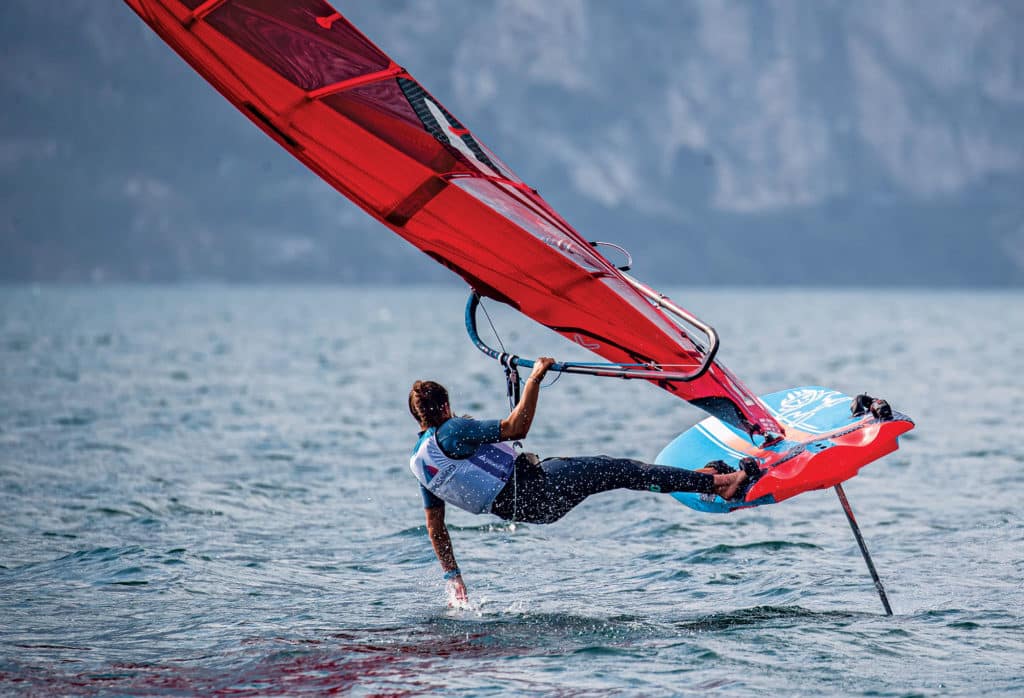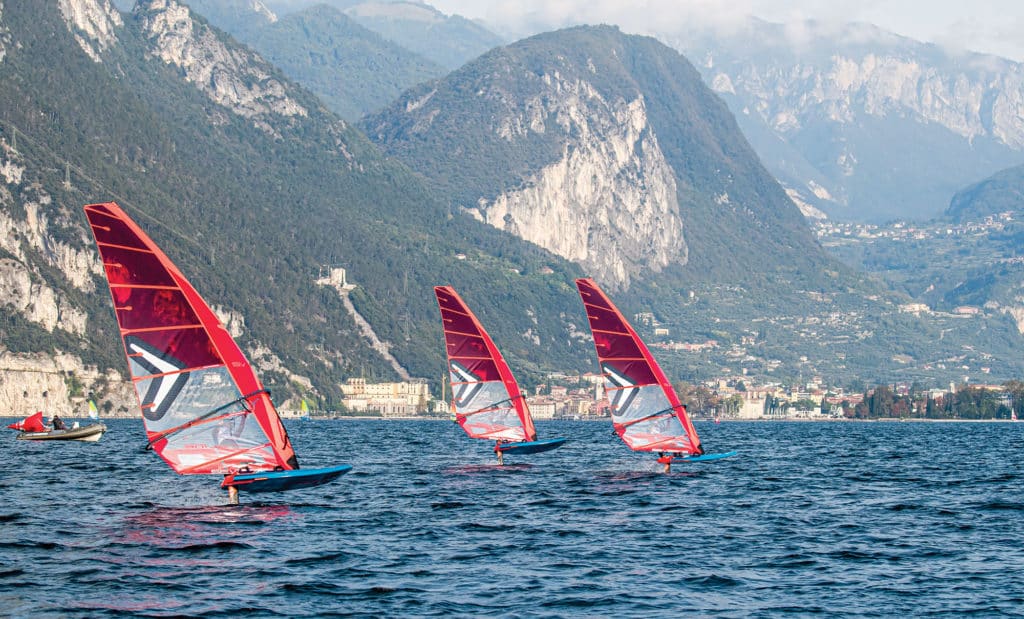
“Windsurfing has been Cancelled.”
If you recall those brazen, arrogant bumper stickers from the early 2000s that sparked an outrage at the dawn of kitesurfing, then you’ll know what I’m talking about. That time Matt Nuzzo and Trip Forman took an Outside magazine writer out for a session, threw windsurfing under the bus and brainwashed the nation. Kiting is the future!
Their timing of that subsequent article in 2006, using the sticker’s moniker as a title, was perfect.
Windsurfing’s participation took a nosedive thanks to the equipment-heavy lust for big-wind shortboarding. Nuzzo and Forman, former windsurfers, were young, hip and with their fledgling REAL Kiteboarding operation in Cape Hatteras, were ready to receive a new generation of thrill seekers. Kiteboarding has been the fastest-growing wind-driven watersport ever since.
I was on the beach with those two radicals when they were first being yanked around by ram-air kites at the dawn of this millennium. And I left windsurfing almost wholesale like many others did in the United States and elsewhere. Less gear, riding in 15 knots or 40 knots, boosting 20-foot airs at will, what could be more exciting?

Maybe those blasphemous marketers were promoting the sign of the times, but it has taken almost 20 years for windsurfing to find its new inspiration. With World Sailing’s election of Starboard’s iFoil over the existing RS:X class as the men’s and women’s Olympic windsurfing equipment for Paris 2024, I’m here to tell you: Windfoiling is the future.
Windfoiling is exploding in Europe just as SUP foiling is booming in the surf industry around the world, but windsurfing 2.0 is still in its nascent stages with regard to equipment development and participation. The first Formula Windsurfing Foil World Championships were held in 2018, and in the United States, only small pockets of board heads in the Chesapeake Bay, Florida and the Columbia River Gorge in Oregon are using foils. Why pick windfoiling for the Olympics when it’s so new and barely established?
The choice was obvious to World Sailing. We forget that more and more, the International Olympic Committee insists that our events have broadcast appeal. This is why representatives from both the Equipment and Events committees made up the Paris 2024 Windsurfer Evaluation Working Party that recommended the iFoil at World Sailing’s annual conference in November. The Events Committee focuses on race format and presentation.
Trials were held on Lake Garda with the RS:X and Glide representing the planing option (stuck to the water) while the iFoil, Windfoil 1 and Formula Foil were the flyers. The windfoilers wound up being the clear choice of all the riders who represented professional, Olympic and youth windsurfing. Some of the athletes had never even windfoiled.
RS:X women’s world champion Lilian de Geus says she windfoils all the time in the Netherlands. Izzy Adcock, the youngest rider at 17, says she rips around with a large group of recreational windfoilers in her home waters of Portland Harbor.
“Portland Harbor is lovely and flat,” she tells me when we catch up after the equipment trials. “There’s almost always people out windfoiling. Not loads of youth yet. Most are focused on the RS:X.”
Adcock hints at an important point: Globally, the RS:X is used primarily for Olympic training and racing. What are top windsurfers doing for fun? Foiling.
“[Windfoiling] strengthens sailing’s position in the Games,” says Dina Kowalyshyn, Equipment Committee chair. She says she was excited to explore new slalom formats knowing the iFoil can hop up on foils in only 5 knots of breeze. Consistent jibing happens at 10 knots, and the equipment trials showcased the raw speed of foiling: doubling the windspeed in the lower wind range.
Kowalyshyn also accepts the lack of appetite for watching young, insanely fit RS:X windsurfers air-rowing their way around a course at 3 knots when the breeze drops below 15 knots. And let’s face it, there’s a lot of sub-planing sailing around the world.
“We knew it was going to be the iFoil by the time we left Garda,” she says.
Two-time and reigning Olympic gold medalist Dorian van Rijsselberghe, of Denmark, led an impassioned promotional campaign for windfoiling leading up to the trials, complete with a promotional video and a plea to the World Sailing council.
He says in a Twitter video, “The new generation of hydrofoiling is opening up a lot of places and conditions that normally, quite frankly, make sailing look a little bit boring.”
Legendary windsurfer Robby Naish stayed out of the selection fray, but he too has been doing his part promoting the new form of the sport in relaxed and inspiring YouTube videos of him flying around Kailua Bay with a tiny sail and no harness, proving that windfoiling doesn’t need starting lines and tetrahedrons to be fun and popular.
Starboard’s founder, the contagiously positive Svein Rasmussen, says windfoiling opens more days for exciting windsurfing.
“The rigs we now use are smaller for a given wind strength, so easier to handle,” he says. “The smooth ride is indeed easier on the body.”
Rasmussen predicts that in five years, windsurfing will be rejuvenated, with more kids, more women and more light-wind areas activated. “We already see 10-year-old kids foil,” he says. “The new thrill is exhilarating and more addictive.”
The criteria for Olympic equipment selection are straightforward: Cost, quality and availability are all taken into consideration. The suitability for multiple formats is also a criteria. If the equipment is a production one-design, that helps too.
The iFoil checked the latter box. With an 86-square-foot sail for women and a 96-square-foot sail for men, there are two “fuselage” lengths (the horizontal strut that supports both forward and tail foils) and a long fin for sailing in traditional “planing” mode. Kowalyshyn says this fin option allows the board to be used in high winds by novices until their foiling skills progress.
The Equipment Committee chose the iFoil because it was the simplest kit with the fewest parts and the most balanced feel. Watching any of the windfoilers slide effortlessly by the sailors pumping away on the RS:X made the current Olympic equipment look like what it actually is: painful and dated.
Adcock was a surprising and valuable addition to the test riders. She is petite at less than 132 pounds, and had been windfoiling for almost a year while racing Bic Techno boards in youth competition. She placed third at the 2019 IFCA Women’s Foil World Championships. Kowalyshyn says Adcock handled the 25-knot breezes better than most of the larger riders participating in the test event.
“I’ve always had an issue with weight differences,” Adcock says. “Once you’re overpowered, we are the same speed within reason, so it’s just about locking in. There’s a lot you can do to tune for weight. Rear foil angle changes power. Also, moving the mast track position forward when overpowered makes a big difference.”
The iFoil becomes the fourth Olympic event of 10 to use foiling equipment for 2024. This is pretty dramatic considering the Nacra 17 is the only foiling class in 2020. Of all the Olympic foilers, however, windfoiling is perfectly placed to boost viewership in sailing. It’s fast in all conditions. The athlete is also visibly linked to the equipment—as opposed to kiting where the kite is high and out of the camera frame. It can be raced on tight and variable courses, and it looks stunning. Better yet, it’s truly accessible and portable.
Windsurfing is exactly where kiting was in 2012, but the difference now is the windfoiling transition has already begun globally. If kiting was selected as an event then, the equipment would have been immediately behind the times. Looking at the Professional Windsurfing Association and Formula Windsurf trajectory at the moment, World Sailing—maybe for the first time ever—is right on pace with modern sailing-equipment developments by selecting a windfoiler.
Unlike many Olympic classes, windfoiling doesn’t need the Games to grow and spread its roots. Are there true 49er and 470 fleets in your town? Are people sailing these boats just to have fun? No. They need the Games. Tapping into an increasingly popular, inclusive and fun-focused community can only help the sport of sailing—and Olympic sailing by extension.
It’s too early to foresee how the iFoil’s selection for 2024 will affect windsurfing and Olympic sailing, but I suspect those now getting into windfoiling are doing so because they can go 20 to 30 knots in light or heavy wind. Older-generation windsurfers are ripping around again because it’s easier on the body, and they can get more days on the water in light winds. Kids are also picking it up annoyingly fast.
Remember, it took nearly 20 years for windsurfing to recover from a devastating blow dealt by the emergence of kiteboarding, but windfoiling has this wind-and-board community more excited than ever. World Sailing’s selection for 2024 couldn’t be more perfectly timed. Think of it as a multiplier, and more sailors on the water is better for us all.
And then, wonder what the new bumper sticker could read.









